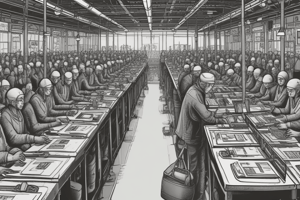Podcast
Questions and Answers
Which of the following is a common criticism of multinational enterprises that utilize sweatshop labor?
Which of the following is a common criticism of multinational enterprises that utilize sweatshop labor?
- Failing to innovate in production methods.
- Prioritizing environmental concerns over worker welfare.
- Investing excessively in worker training programs.
- Exploiting workers' vulnerability. (correct)
According to the argument presented, what is the primary reason why taking away the sweatshop option could be considered wrong?
According to the argument presented, what is the primary reason why taking away the sweatshop option could be considered wrong?
- It encourages innovation in labor practices.
- It reduces dependence on international supply chains.
- It stimulates local economies.
- Sweatshop workers' choice expresses their preference, and taking away that option likely harms them. (correct)
What does the argument suggest about the relationship between choice and autonomy in the context of sweatshop labor?
What does the argument suggest about the relationship between choice and autonomy in the context of sweatshop labor?
- Choice is always fully autonomous, regardless of circumstances.
- Autonomy is only possible in developed economies.
- Choice, even if constrained, can be an exercise of autonomy. (correct)
- Choice is irrelevant when economic conditions are dire.
What is a key consideration when evaluating the ethics of sweatshop labor, as suggested in the text?
What is a key consideration when evaluating the ethics of sweatshop labor, as suggested in the text?
What is the potential negative consequence of regulations aimed at improving working conditions in sweatshops?
What is the potential negative consequence of regulations aimed at improving working conditions in sweatshops?
Which statement aligns with the presented argument regarding the preferences of workers in sweatshops?
Which statement aligns with the presented argument regarding the preferences of workers in sweatshops?
What is the main point of contention in the debate over sweatshops?
What is the main point of contention in the debate over sweatshops?
How does the argument address the claim that sweatshop workers are coerced?
How does the argument address the claim that sweatshop workers are coerced?
Premises 1-4 are considered what type of assumptions?
Premises 1-4 are considered what type of assumptions?
What is a result of the anti-sweatshop campaigns in Indonesia during the 1990s?
What is a result of the anti-sweatshop campaigns in Indonesia during the 1990s?
What is the main point in getting rid of the jobs because it's not good conditions to work in and it's _______ labor.
What is the main point in getting rid of the jobs because it's not good conditions to work in and it's _______ labor.
How does coercion reduce a person's options?
How does coercion reduce a person's options?
Can the benefits outweigh the harm regarding regulations and enforcement?
Can the benefits outweigh the harm regarding regulations and enforcement?
Sweatshop is a factory where manual laborers are employed at very _____ wages.
Sweatshop is a factory where manual laborers are employed at very _____ wages.
What is one factor that can improve conditions for workers in developing countries?
What is one factor that can improve conditions for workers in developing countries?
Flashcards
Sweatshop
Sweatshop
A factory or workshop where manual laborers are employed at very low wages, for long hours, and with poor working conditions.
Exploitation
Exploitation
Taking advantage of weaknesses, often used to describe the criticism of sweatshops.
Agent's Autonomy
Agent's Autonomy
The capacity of an individual to make their own decisions, which can be used as an argument against banning sweatshops.
Agent's Preferences
Agent's Preferences
Signup and view all the flashcards
Argument Conclusion
Argument Conclusion
Signup and view all the flashcards
Policy Implications
Policy Implications
Signup and view all the flashcards
Objection to Sweatshops
Objection to Sweatshops
Signup and view all the flashcards
regulation, jobs
regulation, jobs
Signup and view all the flashcards
Study Notes
Sweatshops
- Defined as factories or workshops employing manual laborers at very low wages, long hours, and with poor working conditions.
- Multinational enterprises using sweatshop labor are often criticized for:
- Exploiting workers' vulnerability
- Failing to respect workers as persons (Kantian)
- Ignoring human rights abuses
- Being complicit with repressive regimes by denying worker's rights and not enforcing minimum standards
Transformative Power of Choice
- Choice is an exercise of an agent's autonomy
- Even if not fully autonomous, it generates a strong claim of non-interference
- Choice expresses an agent's preferences
- Choosing to work at a sweatshop expresses a preference for that option, so removing it causes great harm
- Preferences of the coerced can still be morally significant (Mugging case)
The Argument: Two Arguments in One
- Most sweatshop workers' choice is an exercise of autonomy
- Taking away the sweatshop option will violate the workers' autonomy
- It is wrong to violate autonomy, all else equal
- Sweatshop workers' choice expresses their preference.
- Taking away the sweatshop option will probably harm the workers.
- It is wrong to harm people, all else equal
- Therefore, all things being equal, it is wrong to take away the sweatshop option from those who would choose it
The Argument In Full
- Sweatshop workers choose to accept their employment conditions, even if from a severely constrained set of options
- Choosing those conditions suggests they view it as their most-preferred option
- Viewing it as their most-preferred option indicates that removing that option will harm them
- Workers' choice is sufficiently autonomous, thus removing the option would violate their autonomy
- All else being equal, it is wrong to harm people or violate their autonomy
- Therefore, it is wrong to take away the option of sweatshop labor from workers who would choose it
- Premises 1-4 are empirical assumptions that can be challenged
Clarifications
- The argument does not take a stance on whether sweatshops themselves are morally good or bad
- It acknowledges many activities in sweatshops are immoral and should change
- Sometimes, interference can be justified, especially if the wrongs of violating workers' autonomy can be morally justified in specific circumstances.
Policy Implications
- Legal bans on sweatshops and sweatshop-produced goods are wrong
- Regulations that aim to ameliorate working conditions in sweatshops are similarly wrong
Objection & Reply: Failure of Voluntariness
- Objection: workers are coerced by dire economic circumstances/are ignorant or not fully rational
- Responses:
- Coercion doesn't always justify ignoring stated preferences
- Coercion is bad because it reduces options; removing the best option is a further form of coercion
- Some workers may be ignorant/irrational, but that doesn't mean the option should be removed for all
- Even if all are ignorant/irrational, removing the sweatshop option isn't necessarily the best solution
Questions
- Do minimum wage/maximum hour laws necessarily remove options from workers?
- Even if these regulations lead to decline of employment and harm to workers, do the benefits of more regulation outweigh the harm?
Studying That Suits You
Use AI to generate personalized quizzes and flashcards to suit your learning preferences.




